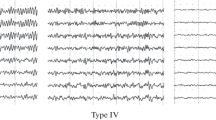Summary
Electrocardiographic (ECG) aspects of skin diving were monitored by means of continuous ECG recording in a pool 15 m deep. Ten regularly trained divers with different levels of experience divid a minimum of three consecutive times, holding their beath, reaching depths of 6 m, 9 m, and 12 or 15 m. The water temperature was 28° C. During the ascending part of these dives, bradycardia was observed in all skin-divers. Minimal heart rate correlated negatively with the diver's experience (number of dives previously performed). In six divers cardiac arrhythmia was observed. Atrial arrhythmias were sometimes isolated occurrences, but more frequently they were multiple. Ventricular arrhythmias tended to be bigeminal. Apparently, forced expiration through the snorkel when sufacing precipitated these rhythmic disorders.
Similar content being viewed by others
References
Aviado DM, Kalow W, Schmidt CF, Turnbel GL, Peskin GW, Ness M, Weiss AJ (1951) Respiratory and circulatory reflex from the perfused heart and pulmonary circulation of the dog. Am J Physiol 2:165–261
Djiane P, Egre A, Bory M, Savin B, Mostepha S, Serradimigni A (1979) L'enregistrement électricardiographique chez les sujets normaux. Arch Mal Coeur 72:655–661
Elsner R, Gooden B (1963) Diving and asphyxia. Cambridge University Press, Cambridge
Elsner R, Scolander PF (1965) Circulatory adaptations to diving in animals and man. In: Rahn H, Yokoyama T (eds) Physiology of breath hold diving and the Ama of Japan. Natl Acad Sci, Washington, pp 281–294
Faris JV, Mac Henry PL, Jordan GW, Morris SN (1976) Prevalence and reproductibility of exercise induced ventricular arrhythmia during maximal exercise testing in normal men. Am J Cardiol 37:617–625
Friemel F, Cahen B, Larger C, Duizabo D, Seroussi S (1983) Modifications des propriétés élastiques des poumons au cours de la pratique de la plongée sous-marine. Med Sub Hyp 2:1–10
Gauer OH, Henry JP (1976) Neurohormonal control of plasma volume Int Rev Physiol, Cardiovasc Physiol 9:145–190
Hugues T, Carter J, Wolf S (1981) Disorders of cardiac conduction accompanying the dive reflex in man. Pavlov J Biol Sci 16:25–33
Irving L (1963) Bradycardia in human divers. J Appl Physiol 18:489–491
Lancelin B (1980) Exploration et physiologie de la circulation pulmonaire. Conf Cardiol 27:82–102
Lange L, Lange S, Echt M, Gauer OH (1974) Heart volume in relation to body posture and immersion in a thermoneutral bath. A roentgenometric study. Pflügers Arch 352:211–219
Laurent M, Miam B, Almange C, Leborgne G (1982) Comparaison des données de l'épreuve d'effort et de l'enregistrement électrocardiographique continu chez des patients présentant des extrasystoles ventriculaires. Arch Mal Coeur 75:653–659
Mancia G, Lorenz RR, Sheperd JT (1976) Reflex control of circulation by heart and lungs. Int Rev Physiol Cardiovasc Physiol 9:111–144
Moore TO, Bernauer G, Seto YS, Park SK, Hong H, Hayasm EM (1970) Effect of immersion at different water temperature on graded exercise performance in man. Aerosp Med 41:1404–1408
Moore TO, Lin YC, Lally DA, Hong SK (1972) Effect of temperature, immersion and ambient pressure on human apneic bradycardia. J Appl Physiol 33:36–41
Paulev PE, Hansen HG (1972) Cardiac response to apnea and water immersion during exercise in man. J Appl Physiol 33:193–198
Sasamoto H (1965) The electrocardiogram pattern of the diving Ama. In: Rahn H, Yokoyama T (eds) Physiology of breath hold diving and the Ama of Japan. Natl Acad Sci, Washington, pp 271–280
Sciarli RJ (1976) La médecine de plongée. Océan
Song SH, Lee WK, Chung YA, Hong SK (1969) Mechanism of apneic bradycardia in man. J Appl Physiol 27:323–327
Whayne TF, Killip T (1967) Simulated diving in man: comparison of facial stimuli and response in arrhythmia. J Appl Physiol 22:800–807
Wolf S (1965) The bradycardia of the dive reflex — a possible mechanism of sudden death. Trans Am Clin Climatol Assoc 76:192–200
Author information
Authors and Affiliations
Rights and permissions
About this article
Cite this article
Bonneau, A., Friemel, F. & Lapierre, D. Electrocardiographic aspects of skin diving. Europ. J. Appl. Physiol. 58, 487–493 (1989). https://doi.org/10.1007/BF02330702
Issue Date:
DOI: https://doi.org/10.1007/BF02330702



